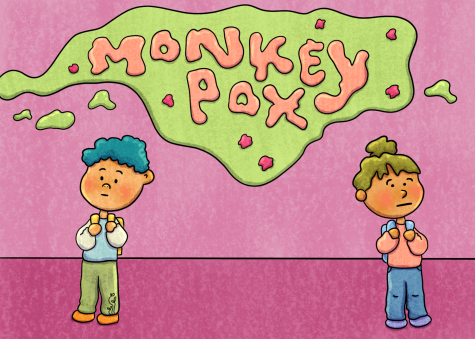Another semester, another public health threat: What to know about monkeypox and returning to campus
August 31, 2022

Despite not posing the same level of health threat as COVID-19 and remaining relatively limited in community spread, Columbia is monitoring the spread of the monkeypox virus and is not implementing any specific precautions at this time.
As of now, testing for monkeypox is not available at the Student Health Center or through CareATC, but testing and vaccines are available elsewhere in Chicago according to an email sent from Columbia on Aug. 8.
Currently, vaccines are not widely accessible for those who are not considered high-risk, but testing is available from the Chicago Department of Public Health. To book a test, call the department at 312-746-4835.
Data from the Centers for Disease Control and Prevention on monkeypox cases suggest that gay, bisexual and other men who have sex with men make up the majority of the outbreak’s cases; however, anyone who is in close contact with someone who is positive for monkeypox is considered high-risk.
As of Aug. 16, vaccine eligibility locally includes those living in Chicago and Illinois, including students enrolled at Chicago’s colleges who have not tested positive before. The criteria includes having close contact with someone positive for monkeypox or sexually active bisexual, gay or other men who have sex with men or transgender persons. As of now, vaccines are only available for people over the age of 18.
“We are exploring options to have testing available at the Student Health Center, but at this point members of the Columbia community should be aware testing can only confirm/rule out monkeypox once there are physical symptoms like rashes/sores/scabs,” said Chief of Staff Laurent Pernot in an email to the Chronicle on Aug. 24.
As of Aug. 31, there are about 1,069 monkeypox cases in Illinois that have been reported to the CDC. Currently, Illinois is one of the six states with more than a thousand monkeypox cases, following Georgia which has 1,403 cases. California is currently the state with the highest number of reported cases.
According to data from Aug. 31 from the CDPH, there have been 856 cumulative cases reported in the city, 49 hospitalizations and zero deaths.
Pernot said monkeypox, unlike COVID-19, is easier to identify and is less likely to be a “silent spreader.”
“The good news is that it does not appear people are infectious until there is [a] manifestation of the illness on someone’s skin, and therefore it is less likely than with other diseases like COVID that there might be a lot of ‘silent spread,'” Pernot said.
Pernot said the school is in touch with the CDPH about monkeypox but is currently awaiting formal guidance from the department tailored specifically to institutions of higher education.
As the college is awaiting formal guidance from CDPH, Pernot said Columbia has been consulting with infectious disease experts at Rush University Medical Center.
According to the CDPH, symptoms of monkeypox typically start “several days” to two weeks after exposure to the virus, but may not appear for up to 21 days.
Monkeypox’s most common symptoms are rashes or sores that can look like pimples or blisters around the body. The rash can appear on one body part or across the whole body, including the face, chest, hands, feet, genital and anal regions and inside the mouth.
“The main advice from the experts is to be on the lookout for skin lesions, and to seek a vaccine if individuals fall under the risk groups listed in the resources we linked to in our communication,” Pernot said, referring to the monkeypox information email from the college.
Pernot said the college is preparing to share more information with students and employees as it becomes available and is also finalizing protocols for residence halls, which will be based on CDC, CDPH and Rush University guidelines. Pernot said the college hopes to announce the on-campus protocol soon.
Aside from the rash itself, cases of monkeypox have been reported in tandem with symptoms of fevers, chills, swollen lymph nodes, exhaustion, muscle ache and backaches, headaches and respiratory symptoms, including a sore throat, nasal congestion or cough.
Similarly to COVID-19, the best way to prevent monkeypox is to wash your hands often with soap and water or to use alcohol-based hand sanitizer, especially before eating, touching your face or after using the bathroom.
In contrast, to prevent the spread of monkeypox, people should avoid close, skin-to-skin contact with people who have a rash that looks like monkeypox and avoid objects and materials that a person with the virus has used. This includes sharing eating utensils and cups and touching the bedding, towels or clothing of someone who has monkeypox.
More information from the CDC can be found here, and more information from the Chicago Department of Public Health can be viewed here.
This is a developing story. The Chronicle will publish updated information as more is released.







